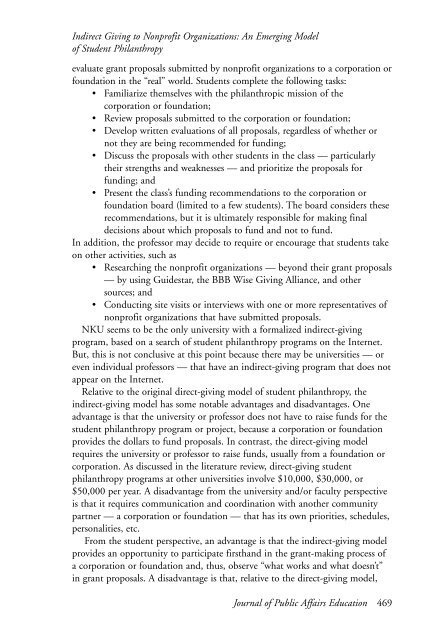JOURNAL OF PUBLIC AFFAIRS EDUCATION - National ...
JOURNAL OF PUBLIC AFFAIRS EDUCATION - National ...
JOURNAL OF PUBLIC AFFAIRS EDUCATION - National ...
Create successful ePaper yourself
Turn your PDF publications into a flip-book with our unique Google optimized e-Paper software.
Indirect Giving to Nonprofit Organizations: An Emerging Model<br />
of Student Philanthropy<br />
evaluate grant proposals submitted by nonprofit organizations to a corporation or<br />
foundation in the “real” world. Students complete the following tasks:<br />
• Familiarize themselves with the philanthropic mission of the<br />
corporation or foundation;<br />
• Review proposals submitted to the corporation or foundation;<br />
• Develop written evaluations of all proposals, regardless of whether or<br />
not they are being recommended for funding;<br />
• Discuss the proposals with other students in the class — particularly<br />
their strengths and weaknesses — and prioritize the proposals for<br />
funding; and<br />
• Present the class’s funding recommendations to the corporation or<br />
foundation board (limited to a few students). The board considers these<br />
recommendations, but it is ultimately responsible for making final<br />
decisions about which proposals to fund and not to fund.<br />
In addition, the professor may decide to require or encourage that students take<br />
on other activities, such as<br />
• Researching the nonprofit organizations — beyond their grant proposals<br />
— by using Guidestar, the BBB Wise Giving Alliance, and other<br />
sources; and<br />
• Conducting site visits or interviews with one or more representatives of<br />
nonprofit organizations that have submitted proposals.<br />
NKU seems to be the only university with a formalized indirect-giving<br />
program, based on a search of student philanthropy programs on the Internet.<br />
But, this is not conclusive at this point because there may be universities — or<br />
even individual professors — that have an indirect-giving program that does not<br />
appear on the Internet.<br />
Relative to the original direct-giving model of student philanthropy, the<br />
indirect-giving model has some notable advantages and disadvantages. One<br />
advantage is that the university or professor does not have to raise funds for the<br />
student philanthropy program or project, because a corporation or foundation<br />
provides the dollars to fund proposals. In contrast, the direct-giving model<br />
requires the university or professor to raise funds, usually from a foundation or<br />
corporation. As discussed in the literature review, direct-giving student<br />
philanthropy programs at other universities involve $10,000, $30,000, or<br />
$50,000 per year. A disadvantage from the university and/or faculty perspective<br />
is that it requires communication and coordination with another community<br />
partner — a corporation or foundation — that has its own priorities, schedules,<br />
personalities, etc.<br />
From the student perspective, an advantage is that the indirect-giving model<br />
provides an opportunity to participate firsthand in the grant-making process of<br />
a corporation or foundation and, thus, observe “what works and what doesn’t”<br />
in grant proposals. A disadvantage is that, relative to the direct-giving model,<br />
Journal of Public Affairs Education 469

















